India, China: How Growth Changes Global Development Strategies
VerifiedAdded on 2023/06/15
|9
|2158
|379
Essay
AI Summary
This essay examines the transformative impact of the rapid economic growth of India and China on global development patterns and strategies. It highlights how the sustained demand in these Asian economies increasingly influences the economic prospects of countries worldwide. The essay discusses the adjustments in the development and growth strategies of both nations, as reflected in their 5-year plans, to address emerging challenges and future hurdles. It explores China's shift towards consumption and services and industrial upgrading, as well as India's focus on increasing economic growth and inclusive development. Furthermore, the essay analyzes the implications of these changes for other regions, such as Africa and the Pacific, noting how China's expanding commercial presence in Africa necessitates agile policy-making by African governments. It also examines how other global economies are adapting their strategies to compete with and counter the influence of China and India in various sectors. The essay concludes that the growth patterns and strategies adopted by India and China are reshaping global trade and development, prompting other nations to adopt similar approaches to maintain their competitive positions.

Political Science 1
POLITICAL SCIENCE
By (Student’s Name)
Professor’s Name
College
Course
Date
POLITICAL SCIENCE
By (Student’s Name)
Professor’s Name
College
Course
Date
Paraphrase This Document
Need a fresh take? Get an instant paraphrase of this document with our AI Paraphraser

Political Science 2
How Is Growth In The Very Large Asian Economies Of India And China Changing Global
Development Patterns And Strategies?
The economic prospect of countries throughout the world has been increasingly reliant on
sustained demand in China and India. Persistent success cannot be taken lightly, though. It is a
fact of history that the trajectories of growth are never sustained on the autopilot. In fact, both
China and India are aiming at the adjustment of their corresponding development and growth
strategies to tackle the challenges that have arisen and major hurdles ahead.
India and China’s 12th 5-year plans (5YPs) display their visions as well as objectives.
Nevertheless, adjustment of development and growth strategies remains complex and
challenging from both political and economic viewpoints. Therefore, there remains a lot of
uncertainties regarding the course of policy and regarding whether and how both countries shall
adjust their growth patterns.
In terms of policy, opening up as well as gradual market-focused reform in China were
merged with a strong role of the administrations in channelling resources to investment and
industry. In fact, the growth has remained especially industry- and investment-focused. This has
permitted China to have a sustained high growth without main macro stress (Loke 2017).
Nevertheless, it has further led to significant imbalances. Since the mid-1980s, India has further
embarked on market-focused reform.
The policies of India have characteristically not targeted explicitly at the investment and
industrialization as much as in India and China’s growth pattern has remained less industry-and
export-focused. The potential growth of GDP of India increased over time as result of higher
investment and total productivity (TFP) growth (Liew 2015). Nevertheless, expectations, as well
as demand, ran ahead of supply-side lately, culminating in macroeconomics tension. Further,
How Is Growth In The Very Large Asian Economies Of India And China Changing Global
Development Patterns And Strategies?
The economic prospect of countries throughout the world has been increasingly reliant on
sustained demand in China and India. Persistent success cannot be taken lightly, though. It is a
fact of history that the trajectories of growth are never sustained on the autopilot. In fact, both
China and India are aiming at the adjustment of their corresponding development and growth
strategies to tackle the challenges that have arisen and major hurdles ahead.
India and China’s 12th 5-year plans (5YPs) display their visions as well as objectives.
Nevertheless, adjustment of development and growth strategies remains complex and
challenging from both political and economic viewpoints. Therefore, there remains a lot of
uncertainties regarding the course of policy and regarding whether and how both countries shall
adjust their growth patterns.
In terms of policy, opening up as well as gradual market-focused reform in China were
merged with a strong role of the administrations in channelling resources to investment and
industry. In fact, the growth has remained especially industry- and investment-focused. This has
permitted China to have a sustained high growth without main macro stress (Loke 2017).
Nevertheless, it has further led to significant imbalances. Since the mid-1980s, India has further
embarked on market-focused reform.
The policies of India have characteristically not targeted explicitly at the investment and
industrialization as much as in India and China’s growth pattern has remained less industry-and
export-focused. The potential growth of GDP of India increased over time as result of higher
investment and total productivity (TFP) growth (Liew 2015). Nevertheless, expectations, as well
as demand, ran ahead of supply-side lately, culminating in macroeconomics tension. Further,
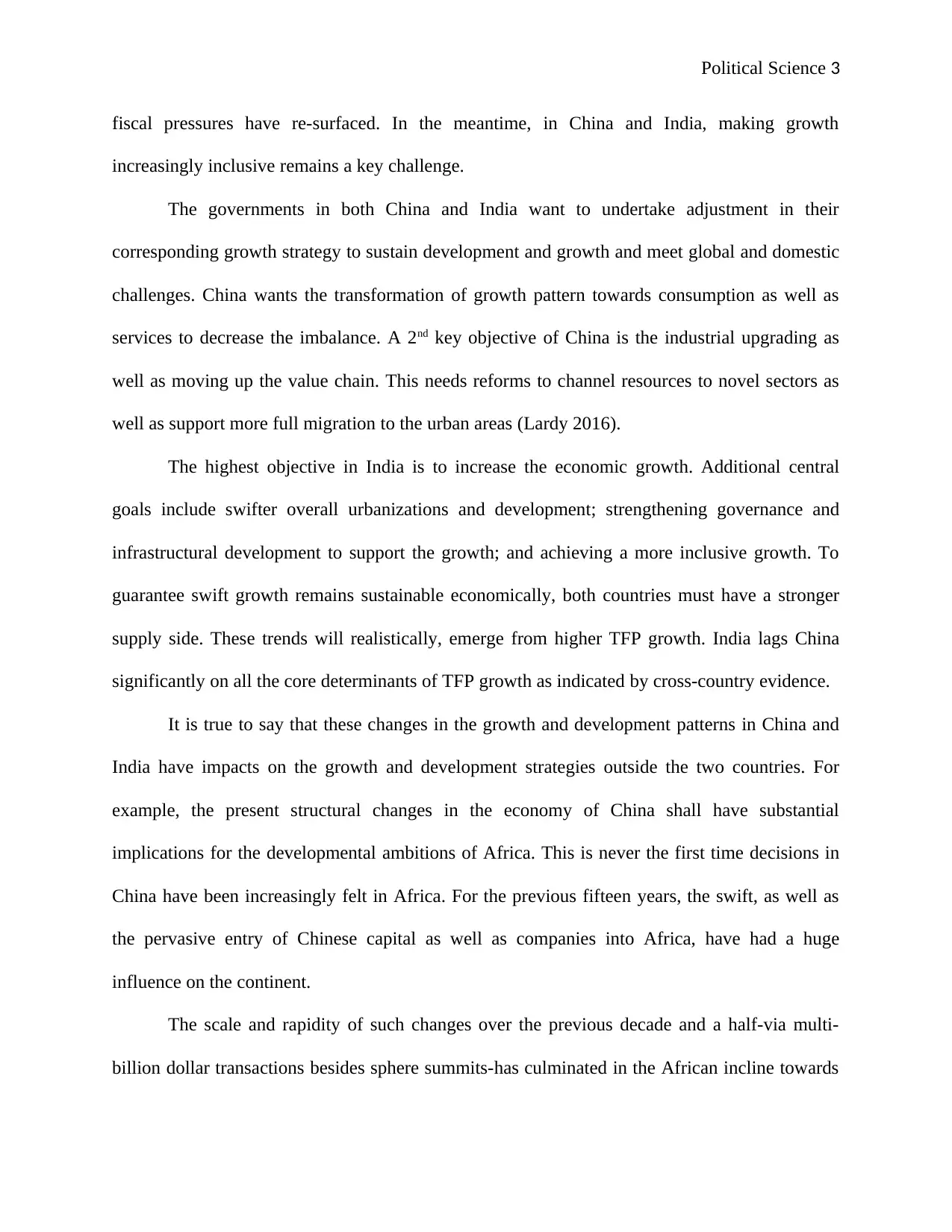
Political Science 3
fiscal pressures have re-surfaced. In the meantime, in China and India, making growth
increasingly inclusive remains a key challenge.
The governments in both China and India want to undertake adjustment in their
corresponding growth strategy to sustain development and growth and meet global and domestic
challenges. China wants the transformation of growth pattern towards consumption as well as
services to decrease the imbalance. A 2nd key objective of China is the industrial upgrading as
well as moving up the value chain. This needs reforms to channel resources to novel sectors as
well as support more full migration to the urban areas (Lardy 2016).
The highest objective in India is to increase the economic growth. Additional central
goals include swifter overall urbanizations and development; strengthening governance and
infrastructural development to support the growth; and achieving a more inclusive growth. To
guarantee swift growth remains sustainable economically, both countries must have a stronger
supply side. These trends will realistically, emerge from higher TFP growth. India lags China
significantly on all the core determinants of TFP growth as indicated by cross-country evidence.
It is true to say that these changes in the growth and development patterns in China and
India have impacts on the growth and development strategies outside the two countries. For
example, the present structural changes in the economy of China shall have substantial
implications for the developmental ambitions of Africa. This is never the first time decisions in
China have been increasingly felt in Africa. For the previous fifteen years, the swift, as well as
the pervasive entry of Chinese capital as well as companies into Africa, have had a huge
influence on the continent.
The scale and rapidity of such changes over the previous decade and a half-via multi-
billion dollar transactions besides sphere summits-has culminated in the African incline towards
fiscal pressures have re-surfaced. In the meantime, in China and India, making growth
increasingly inclusive remains a key challenge.
The governments in both China and India want to undertake adjustment in their
corresponding growth strategy to sustain development and growth and meet global and domestic
challenges. China wants the transformation of growth pattern towards consumption as well as
services to decrease the imbalance. A 2nd key objective of China is the industrial upgrading as
well as moving up the value chain. This needs reforms to channel resources to novel sectors as
well as support more full migration to the urban areas (Lardy 2016).
The highest objective in India is to increase the economic growth. Additional central
goals include swifter overall urbanizations and development; strengthening governance and
infrastructural development to support the growth; and achieving a more inclusive growth. To
guarantee swift growth remains sustainable economically, both countries must have a stronger
supply side. These trends will realistically, emerge from higher TFP growth. India lags China
significantly on all the core determinants of TFP growth as indicated by cross-country evidence.
It is true to say that these changes in the growth and development patterns in China and
India have impacts on the growth and development strategies outside the two countries. For
example, the present structural changes in the economy of China shall have substantial
implications for the developmental ambitions of Africa. This is never the first time decisions in
China have been increasingly felt in Africa. For the previous fifteen years, the swift, as well as
the pervasive entry of Chinese capital as well as companies into Africa, have had a huge
influence on the continent.
The scale and rapidity of such changes over the previous decade and a half-via multi-
billion dollar transactions besides sphere summits-has culminated in the African incline towards
⊘ This is a preview!⊘
Do you want full access?
Subscribe today to unlock all pages.

Trusted by 1+ million students worldwide
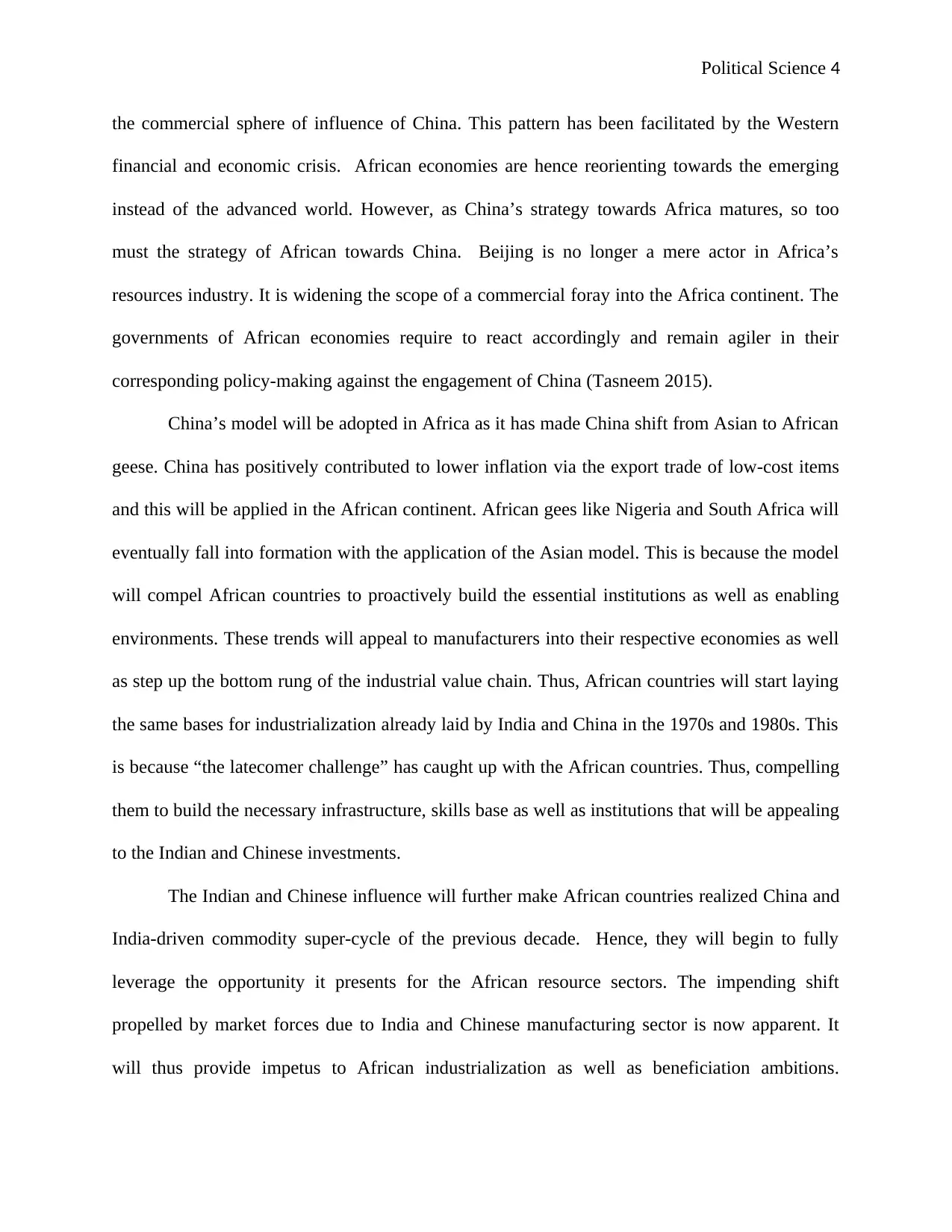
Political Science 4
the commercial sphere of influence of China. This pattern has been facilitated by the Western
financial and economic crisis. African economies are hence reorienting towards the emerging
instead of the advanced world. However, as China’s strategy towards Africa matures, so too
must the strategy of African towards China. Beijing is no longer a mere actor in Africa’s
resources industry. It is widening the scope of a commercial foray into the Africa continent. The
governments of African economies require to react accordingly and remain agiler in their
corresponding policy-making against the engagement of China (Tasneem 2015).
China’s model will be adopted in Africa as it has made China shift from Asian to African
geese. China has positively contributed to lower inflation via the export trade of low-cost items
and this will be applied in the African continent. African gees like Nigeria and South Africa will
eventually fall into formation with the application of the Asian model. This is because the model
will compel African countries to proactively build the essential institutions as well as enabling
environments. These trends will appeal to manufacturers into their respective economies as well
as step up the bottom rung of the industrial value chain. Thus, African countries will start laying
the same bases for industrialization already laid by India and China in the 1970s and 1980s. This
is because “the latecomer challenge” has caught up with the African countries. Thus, compelling
them to build the necessary infrastructure, skills base as well as institutions that will be appealing
to the Indian and Chinese investments.
The Indian and Chinese influence will further make African countries realized China and
India-driven commodity super-cycle of the previous decade. Hence, they will begin to fully
leverage the opportunity it presents for the African resource sectors. The impending shift
propelled by market forces due to India and Chinese manufacturing sector is now apparent. It
will thus provide impetus to African industrialization as well as beneficiation ambitions.
the commercial sphere of influence of China. This pattern has been facilitated by the Western
financial and economic crisis. African economies are hence reorienting towards the emerging
instead of the advanced world. However, as China’s strategy towards Africa matures, so too
must the strategy of African towards China. Beijing is no longer a mere actor in Africa’s
resources industry. It is widening the scope of a commercial foray into the Africa continent. The
governments of African economies require to react accordingly and remain agiler in their
corresponding policy-making against the engagement of China (Tasneem 2015).
China’s model will be adopted in Africa as it has made China shift from Asian to African
geese. China has positively contributed to lower inflation via the export trade of low-cost items
and this will be applied in the African continent. African gees like Nigeria and South Africa will
eventually fall into formation with the application of the Asian model. This is because the model
will compel African countries to proactively build the essential institutions as well as enabling
environments. These trends will appeal to manufacturers into their respective economies as well
as step up the bottom rung of the industrial value chain. Thus, African countries will start laying
the same bases for industrialization already laid by India and China in the 1970s and 1980s. This
is because “the latecomer challenge” has caught up with the African countries. Thus, compelling
them to build the necessary infrastructure, skills base as well as institutions that will be appealing
to the Indian and Chinese investments.
The Indian and Chinese influence will further make African countries realized China and
India-driven commodity super-cycle of the previous decade. Hence, they will begin to fully
leverage the opportunity it presents for the African resource sectors. The impending shift
propelled by market forces due to India and Chinese manufacturing sector is now apparent. It
will thus provide impetus to African industrialization as well as beneficiation ambitions.
Paraphrase This Document
Need a fresh take? Get an instant paraphrase of this document with our AI Paraphraser

Political Science 5
Moreover, the relationship between India and China and Africa is no longer merely regarding the
attraction of state capital. It has gone a notch higher to incorporate private investment. This will
definitely inform the policy of African countries seeking to move past resource to diversify their
corresponding economies by building nascent manufacturing and industry sectors (McMillan,
Rodrik and Verduzco-Gallo 2014). The structural changes in India and Africa, therefore,
currently hold out huge potential for growth for Africa.
China and India will further have great implications for not only Asia but also the greater
Pacific region. Globalization, trade liberalization, as well as the pressure of meeting FTA and
WTO agreements, have increasingly generated a significant growth for trade. China, for instance,
will enjoy the largest influence on Pacific region and Asia since the economy of China is 2.5
times bigger than that of India. China is also growing swifter and remains increasingly integrated
with the entire world (Kuijs 2012).
China received about sixty billion USD for FDI in the previous years as compared to five
billion USD received by India. The FDI alongside multinational investments remains
mechanisms for the importation of technology as well as entrepreneurial alongside management
skills. China is further projected to be the global 2nd largest exporter and importer. These trends
will definitely have impacts on the strategies of growth and development in its leading
competitors. The rivals include the US, Australian, Russian Federation as well as the Middle
East (Lardy 2016).
The global development patterns and strategies will further change to keep pace and
counter the growth in India and China. Some rival economies will have to counter the influence
of China and India in Africa and in other global trade footings. For example, whereas China is
aiming at re-balancing as well as moving up the value chain, India aims at faster as well as more
Moreover, the relationship between India and China and Africa is no longer merely regarding the
attraction of state capital. It has gone a notch higher to incorporate private investment. This will
definitely inform the policy of African countries seeking to move past resource to diversify their
corresponding economies by building nascent manufacturing and industry sectors (McMillan,
Rodrik and Verduzco-Gallo 2014). The structural changes in India and Africa, therefore,
currently hold out huge potential for growth for Africa.
China and India will further have great implications for not only Asia but also the greater
Pacific region. Globalization, trade liberalization, as well as the pressure of meeting FTA and
WTO agreements, have increasingly generated a significant growth for trade. China, for instance,
will enjoy the largest influence on Pacific region and Asia since the economy of China is 2.5
times bigger than that of India. China is also growing swifter and remains increasingly integrated
with the entire world (Kuijs 2012).
China received about sixty billion USD for FDI in the previous years as compared to five
billion USD received by India. The FDI alongside multinational investments remains
mechanisms for the importation of technology as well as entrepreneurial alongside management
skills. China is further projected to be the global 2nd largest exporter and importer. These trends
will definitely have impacts on the strategies of growth and development in its leading
competitors. The rivals include the US, Australian, Russian Federation as well as the Middle
East (Lardy 2016).
The global development patterns and strategies will further change to keep pace and
counter the growth in India and China. Some rival economies will have to counter the influence
of China and India in Africa and in other global trade footings. For example, whereas China is
aiming at re-balancing as well as moving up the value chain, India aims at faster as well as more
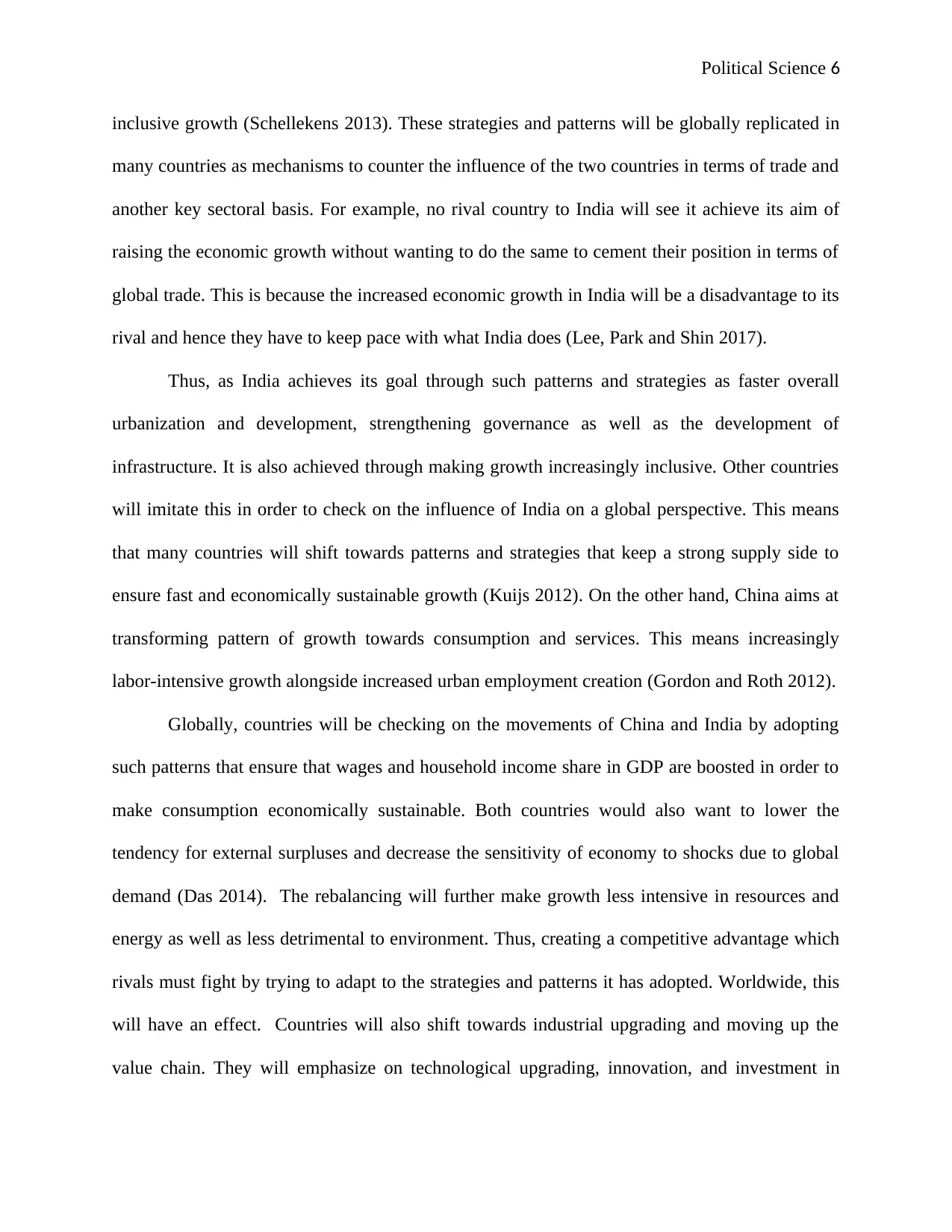
Political Science 6
inclusive growth (Schellekens 2013). These strategies and patterns will be globally replicated in
many countries as mechanisms to counter the influence of the two countries in terms of trade and
another key sectoral basis. For example, no rival country to India will see it achieve its aim of
raising the economic growth without wanting to do the same to cement their position in terms of
global trade. This is because the increased economic growth in India will be a disadvantage to its
rival and hence they have to keep pace with what India does (Lee, Park and Shin 2017).
Thus, as India achieves its goal through such patterns and strategies as faster overall
urbanization and development, strengthening governance as well as the development of
infrastructure. It is also achieved through making growth increasingly inclusive. Other countries
will imitate this in order to check on the influence of India on a global perspective. This means
that many countries will shift towards patterns and strategies that keep a strong supply side to
ensure fast and economically sustainable growth (Kuijs 2012). On the other hand, China aims at
transforming pattern of growth towards consumption and services. This means increasingly
labor-intensive growth alongside increased urban employment creation (Gordon and Roth 2012).
Globally, countries will be checking on the movements of China and India by adopting
such patterns that ensure that wages and household income share in GDP are boosted in order to
make consumption economically sustainable. Both countries would also want to lower the
tendency for external surpluses and decrease the sensitivity of economy to shocks due to global
demand (Das 2014). The rebalancing will further make growth less intensive in resources and
energy as well as less detrimental to environment. Thus, creating a competitive advantage which
rivals must fight by trying to adapt to the strategies and patterns it has adopted. Worldwide, this
will have an effect. Countries will also shift towards industrial upgrading and moving up the
value chain. They will emphasize on technological upgrading, innovation, and investment in
inclusive growth (Schellekens 2013). These strategies and patterns will be globally replicated in
many countries as mechanisms to counter the influence of the two countries in terms of trade and
another key sectoral basis. For example, no rival country to India will see it achieve its aim of
raising the economic growth without wanting to do the same to cement their position in terms of
global trade. This is because the increased economic growth in India will be a disadvantage to its
rival and hence they have to keep pace with what India does (Lee, Park and Shin 2017).
Thus, as India achieves its goal through such patterns and strategies as faster overall
urbanization and development, strengthening governance as well as the development of
infrastructure. It is also achieved through making growth increasingly inclusive. Other countries
will imitate this in order to check on the influence of India on a global perspective. This means
that many countries will shift towards patterns and strategies that keep a strong supply side to
ensure fast and economically sustainable growth (Kuijs 2012). On the other hand, China aims at
transforming pattern of growth towards consumption and services. This means increasingly
labor-intensive growth alongside increased urban employment creation (Gordon and Roth 2012).
Globally, countries will be checking on the movements of China and India by adopting
such patterns that ensure that wages and household income share in GDP are boosted in order to
make consumption economically sustainable. Both countries would also want to lower the
tendency for external surpluses and decrease the sensitivity of economy to shocks due to global
demand (Das 2014). The rebalancing will further make growth less intensive in resources and
energy as well as less detrimental to environment. Thus, creating a competitive advantage which
rivals must fight by trying to adapt to the strategies and patterns it has adopted. Worldwide, this
will have an effect. Countries will also shift towards industrial upgrading and moving up the
value chain. They will emphasize on technological upgrading, innovation, and investment in
⊘ This is a preview!⊘
Do you want full access?
Subscribe today to unlock all pages.

Trusted by 1+ million students worldwide
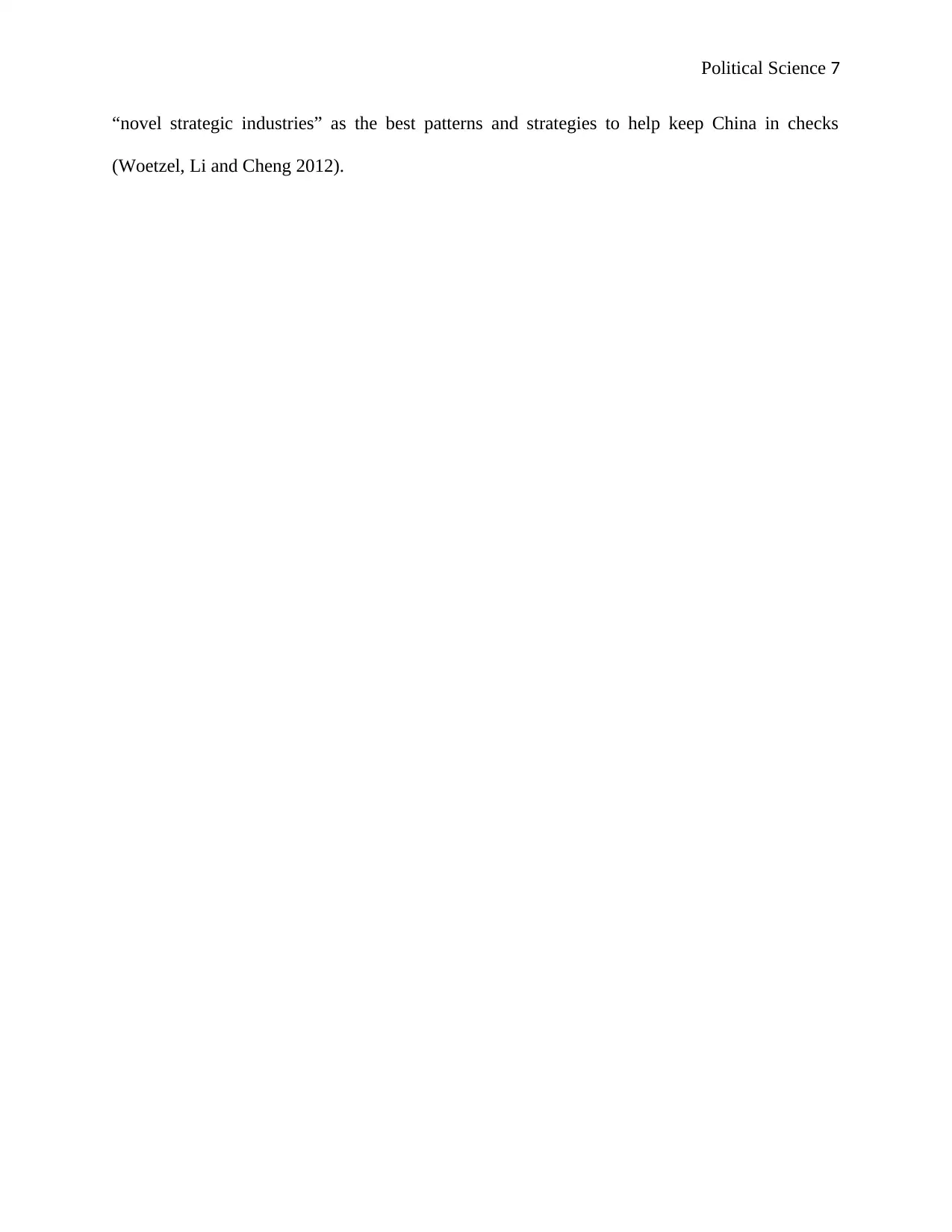
Political Science 7
“novel strategic industries” as the best patterns and strategies to help keep China in checks
(Woetzel, Li and Cheng 2012).
“novel strategic industries” as the best patterns and strategies to help keep China in checks
(Woetzel, Li and Cheng 2012).
Paraphrase This Document
Need a fresh take? Get an instant paraphrase of this document with our AI Paraphraser
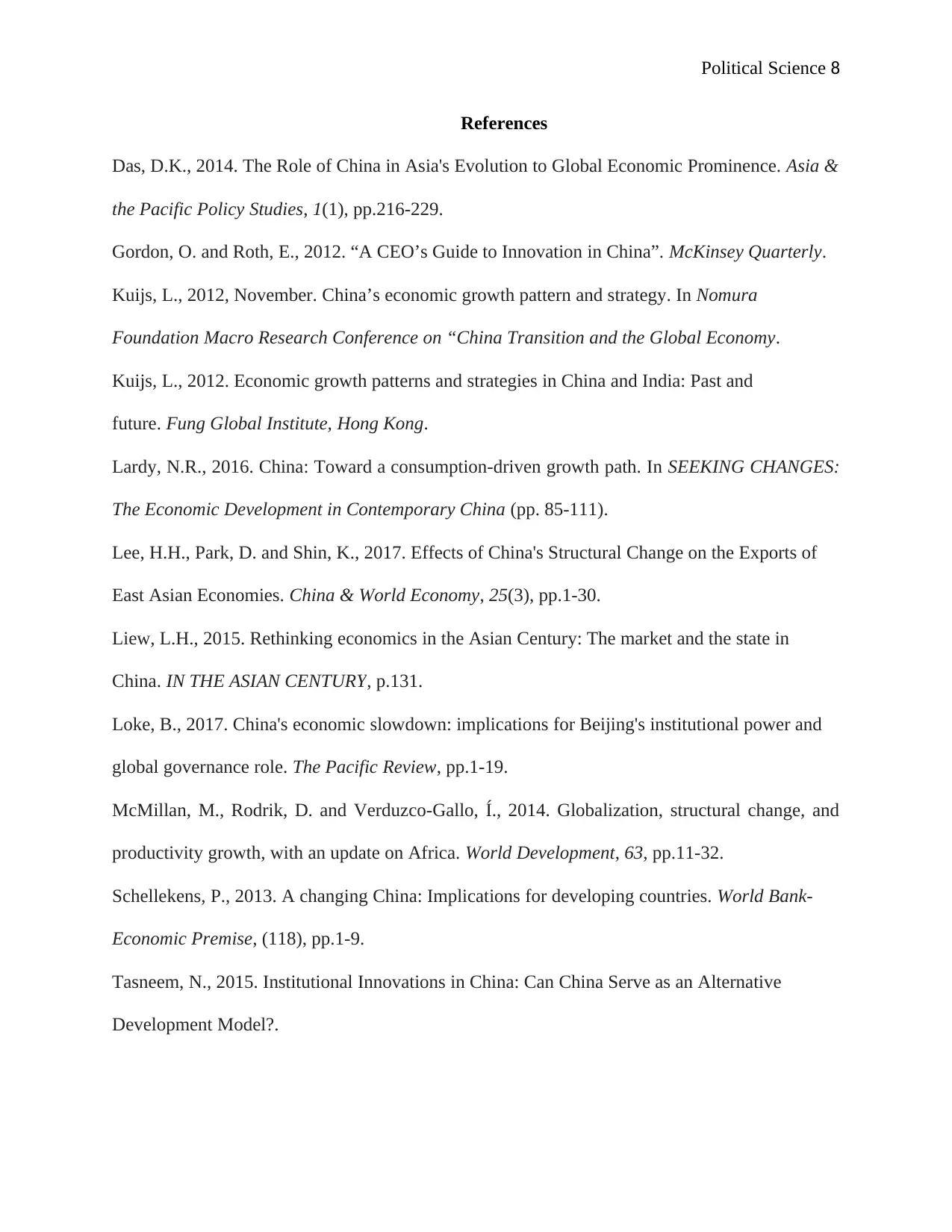
Political Science 8
References
Das, D.K., 2014. The Role of China in Asia's Evolution to Global Economic Prominence. Asia &
the Pacific Policy Studies, 1(1), pp.216-229.
Gordon, O. and Roth, E., 2012. “A CEO’s Guide to Innovation in China”. McKinsey Quarterly.
Kuijs, L., 2012, November. China’s economic growth pattern and strategy. In Nomura
Foundation Macro Research Conference on “China Transition and the Global Economy.
Kuijs, L., 2012. Economic growth patterns and strategies in China and India: Past and
future. Fung Global Institute, Hong Kong.
Lardy, N.R., 2016. China: Toward a consumption-driven growth path. In SEEKING CHANGES:
The Economic Development in Contemporary China (pp. 85-111).
Lee, H.H., Park, D. and Shin, K., 2017. Effects of China's Structural Change on the Exports of
East Asian Economies. China & World Economy, 25(3), pp.1-30.
Liew, L.H., 2015. Rethinking economics in the Asian Century: The market and the state in
China. IN THE ASIAN CENTURY, p.131.
Loke, B., 2017. China's economic slowdown: implications for Beijing's institutional power and
global governance role. The Pacific Review, pp.1-19.
McMillan, M., Rodrik, D. and Verduzco-Gallo, Í., 2014. Globalization, structural change, and
productivity growth, with an update on Africa. World Development, 63, pp.11-32.
Schellekens, P., 2013. A changing China: Implications for developing countries. World Bank-
Economic Premise, (118), pp.1-9.
Tasneem, N., 2015. Institutional Innovations in China: Can China Serve as an Alternative
Development Model?.
References
Das, D.K., 2014. The Role of China in Asia's Evolution to Global Economic Prominence. Asia &
the Pacific Policy Studies, 1(1), pp.216-229.
Gordon, O. and Roth, E., 2012. “A CEO’s Guide to Innovation in China”. McKinsey Quarterly.
Kuijs, L., 2012, November. China’s economic growth pattern and strategy. In Nomura
Foundation Macro Research Conference on “China Transition and the Global Economy.
Kuijs, L., 2012. Economic growth patterns and strategies in China and India: Past and
future. Fung Global Institute, Hong Kong.
Lardy, N.R., 2016. China: Toward a consumption-driven growth path. In SEEKING CHANGES:
The Economic Development in Contemporary China (pp. 85-111).
Lee, H.H., Park, D. and Shin, K., 2017. Effects of China's Structural Change on the Exports of
East Asian Economies. China & World Economy, 25(3), pp.1-30.
Liew, L.H., 2015. Rethinking economics in the Asian Century: The market and the state in
China. IN THE ASIAN CENTURY, p.131.
Loke, B., 2017. China's economic slowdown: implications for Beijing's institutional power and
global governance role. The Pacific Review, pp.1-19.
McMillan, M., Rodrik, D. and Verduzco-Gallo, Í., 2014. Globalization, structural change, and
productivity growth, with an update on Africa. World Development, 63, pp.11-32.
Schellekens, P., 2013. A changing China: Implications for developing countries. World Bank-
Economic Premise, (118), pp.1-9.
Tasneem, N., 2015. Institutional Innovations in China: Can China Serve as an Alternative
Development Model?.

Political Science 9
Woetzel, J., Li, X.L. and Cheng, W., 2012. What’s next for China?. Shanghai, China: McKinsey
& Company.
Woetzel, J., Li, X.L. and Cheng, W., 2012. What’s next for China?. Shanghai, China: McKinsey
& Company.
⊘ This is a preview!⊘
Do you want full access?
Subscribe today to unlock all pages.

Trusted by 1+ million students worldwide
1 out of 9
Related Documents
Your All-in-One AI-Powered Toolkit for Academic Success.
+13062052269
info@desklib.com
Available 24*7 on WhatsApp / Email
![[object Object]](/_next/static/media/star-bottom.7253800d.svg)
Unlock your academic potential
Copyright © 2020–2025 A2Z Services. All Rights Reserved. Developed and managed by ZUCOL.





